You can download our resources from here:
...
Lecture notes are in PDF format
Return Return to home page
| Panel |
|---|
| bgColor | white |
|---|
| titleBGColor | cream |
|---|
|
| Background Color |
|---|
| Our Webinars (recordings) |
| Section |
|---|
| Column |
|---|
| | Panel |
|---|
| bgColor | white |
|---|
| title | Statistical postprocessing |
|---|
| 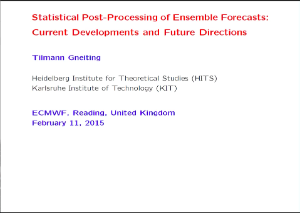
Statistical post-processing of ensemble weather forecasts: Current developments and future directions (Tilmann Gneiting) - Statistical post-processing techniques serve to improve the quality of numerical weather forecasts, as they seek to generate calibrated and sharp predictive distributions of future weather quantities and events. I will review the state of the art in post-processing, with focus on ensemble forecasts and ongoing joint work between the ECMWF and the Computational Statistics group at the Heidelberg Institute for Theoretical Studies (HITS). Current and future challenges include the treatment of extreme events, and the calibration of probabilistic forecasts of combined events and spatio-temporal weather trajectories, for which discrete copula based techniques, such as ensemble copula coupling (ECC) and the Schaake shuffle, are attractive options. . Click here to download the recording. |
|
| Column |
|---|
| | Panel |
|---|
| bgColor | white |
|---|
| title | Ensemble Data Assimilation |
|---|
| 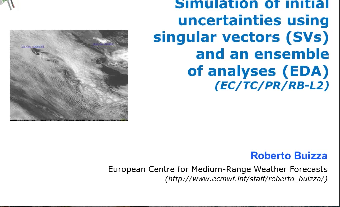
The aim of this webinar is to introduce the ECMWF ensemble of data assimilation (EDA). The rationale and methodology of the EDA will be illustrated, and its use in to simulate initial uncertainties in the ECMWF ensemble prediction system (ENS) will be presented.This webinar was delivered by Dr. Roberto Buizza and recorded in May 2014. Click here to download the recording. |
|
| Column |
|---|
| | Panel |
|---|
| bgColor | white |
|---|
| title | Multi-model ensemble predictions on seasonal timescale |
|---|
| 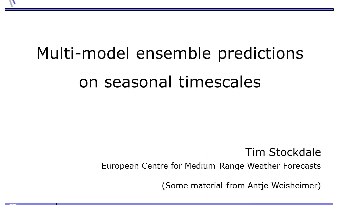
This lecture looks at calibration and multi-model ensembles from a seasonal forecasting perspective. The theoretical basis is given, followed by research results that strongly motivated a multi-model approach for these timescales. The operational EUROSIP multi-model system is described. This Webinar was delivered by Dr. Tim Stockdale and recorded in May 2014. Click here to download the recording. |
|
|
| Expand |
|---|
| title | CLICK HERE FOR MORE RECORDINGS..... |
|---|
| | Section |
|---|
| Column |
|---|
| | Panel |
|---|
| bgColor | white |
|---|
| title | Introduction to surface processes |
|---|
|  This Webinar was delivered by Dr. Gianpaolo Balsamo and recorded in May 2013. It is an introduction to surface processes that are relevant for NWP models. Click here to download the recording. |
|
| Column |
|---|
| | Panel |
|---|
| bgColor | white |
|---|
| title | Data assimilation of surface parameters (part 1) |
|---|
| 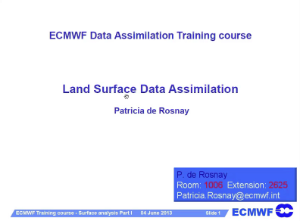 This webinar was delivered by Dr. Patricia De Rosnay and recorded in May 2013. It is the first of two webinars on Data Assimilation for surface parameters. It covers assimilation techniques used at ECMWF. Click here to download the recording. |
|
| Column |
|---|
| | Panel |
|---|
| bgColor | white |
|---|
| title | Data assimilation of surface parameters (part 2) |
|---|
| 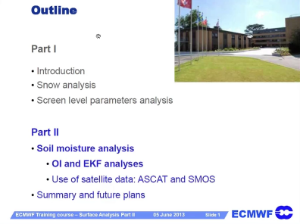 This webinar was delivered by Dr. Patricia De Rosnay and recorded in May 2013. It is the second of two webinars on Data Assimilation for surface parameters. It covers assimilation techniques used at ECMWF. Click here to download the recording. |
|
|
| Section |
|---|
| Column |
|---|
| | Panel |
|---|
| bgColor | white |
|---|
| title | Extra-tropical cyclones and their tracking |
|---|
| 
This Webinar was delivered by Mr. Tim Hewson and recorded in February 2015. The process by which extra tropical cyclones are identified and tracked in the ECMWF IFS analyses and forecasts will be described, and this will be followed by an overview of the multi-faceted web products that relate, and how to use them. Reference will also be made to objective fronts. Click here to download the recording (Lecture slides are available here) |
|
| Column |
|---|
| | Panel |
|---|
| bgColor | white |
|---|
| title | Monthly Forecast |
|---|
| 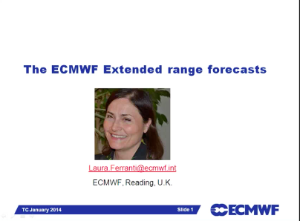
This Webinar was delivered by Dr. Laura Ferrati and recorded in February 2015. This presentation is an introduction to the ECMWF Extended range forecasts. The main sources of predictability at the sub-seasonal time scale will be introduced. The ECMWF forecasting system will be discussed as well as its products and its past performance. Click here to download the recording. (Lectures slides are available from here) |
|
| Column |
|---|
| | Panel |
|---|
| bgColor | white |
|---|
| title | Seasonal Forecast at ECMWF |
|---|
| 
This Webinar was delivered by Dr. Laura Ferrati and recorded in February 2013. It describes the Seasonal Forecasting system at ECMWF, its products and their interpretation. Click here to download the recording. |
|
|
| Section |
|---|
| Column |
|---|
| | Panel |
|---|
| bgColor | white |
|---|
| title | Coud and precipitation: from model to forecasting |
|---|
| 
This Webinar was delivered by Dr. Richard Forbes and recorded in February 2015. This seminar will describe how cloud and precipitation is represented in the ECMWF global model with examples of model evaluation against different types of observations and strengths and weaknesses highlighted. The cloud related forecast products are discussed with some insights into interpretation in different meteorological situations. By the end of this seminar you should be able to: 1. Describe how cloud and precipitation is represented in the ECMWF global model 2. Recognise some of the strengths and weaknesses of the forecast cloud/precipitation. 3. Interpret cloud and precipitation related forecast products. Click here to download the recording. (Lectures slides are available from here) |
|
| Column |
|---|
| | Panel |
|---|
| bgColor | white |
|---|
| title | Understanding the model climate |
|---|
| 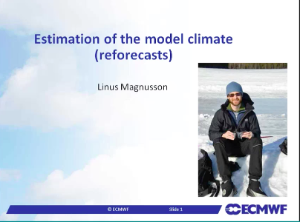
This Webinar was delivered by Dr. Linus Magnuson and recorded in February 2015. The aim the lecture is to give a motivation for why ECMWF produces a data set for the model climate, explain the configuration of it and discuss some of the strengths and weaknesses (limitations). In the lecture we will also explain the cumulative distribution function of the model climatology, as a background for the extreme forecast index (EFI). Click here to download the recording. (Lectures slides are available from here). |
|
| Column |
|---|
| | Panel |
|---|
| bgColor | white |
|---|
| title | Model errors and diagnostic tools |
|---|
| 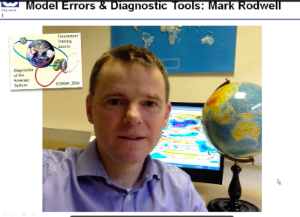
This webinar was delivered by Dr. Mark Rodwell and recorded in February 2015. Diagnostics at ECMWF is about looking for weaknesses in the forecasting system, trying to identify their causes, working with developers, and documenting the resulting changes in performance. As observation volumes increase, and models get more complex, accurate and represent smaller-scale weather features, and as the need for uncertainty information grows, diagnostic tools need to be ever more powerful and precise. Here, with the help of a few case studies, I will discuss the development of these tools, and how they are helping us identify residual deficiencies. Click here to download the recording. (Lectures slides are available from here). |
|
|
| Section |
|---|
| Column |
|---|
| | Panel |
|---|
| bgColor | white |
|---|
| title | Forecasting extreme events |
|---|
| 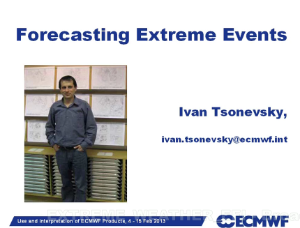 This webinar was delivered by Mr. Ivan Tsonevsky and recorded in February 2015. The Extreme Forecast Index (EFI) has been developed at ECMWF to alert forecasters to anomalous or extreme weather events by comparing the Ensemble Forecasts (ENS) with the model climate as a reference. The Shift Of Tails (SOT) was implemented in 2012 to complement the EFI by providing additional information about the extremity of a given weather event. This talk will give an overview of the use and interpretation of the EFI and SOT for forecasting extreme weather. It will provide information about some limitations of the EFI products and the future plans in the severe weather forecasting at ECMWF. A lot of practical examples will be used throughout the talk to explain and clarify different aspects of the EFI products in forecasting hazardous and anomalous weather events. Click here to download the recording. (Lectures slides are available from here). |
|
| Column |
|---|
| | Panel |
|---|
| bgColor | white |
|---|
| title | Sources of Uncertainties |
|---|
| 
The aim of this webinar is to introduce the main sources of uncertainty that lead to forecast errors. The weather prediction problem will be discussed, and stated it in terms of an appropriate probability density function (PDF). The concept of ensemble prediction based on a finite number of integration will be introduced, and the reason why it is to be the only feasible method to predict the PDF beyond the range of linear growth will be illustrated.This Webinar was delivered by Dr. Roberto Buizza and recorded in May 2014. Click here to download the recording. |
|
|
|
|
| Panel |
|---|
| bgColor | white |
|---|
| titleBGColor | cream |
|---|
|
| Background Color |
|---|
| Our Slidecasts (slides and audio recordings) |
| Section |
|---|
| Column |
|---|
| | Panel |
|---|
| bgColor | white |
|---|
| title | Sources of predictability beyond the deterministic limit |
|---|
| 
This lecture was delivered by Dr. Franco Molteni and recorded in May 2014. Click here to download the recording |
|
| Column |
|---|
| | Panel |
|---|
| bgColor | white |
|---|
| title | Teleconnections and interannual variability of the atmosphere |
|---|
| 
This lecture was delivered by Dr. Franco Molteni and recorded in May 2014. Click here to download the recording |
|
| Column |
|---|
| | Panel |
|---|
| bgColor | white |
|---|
| title | Weather Regimes |
|---|
| 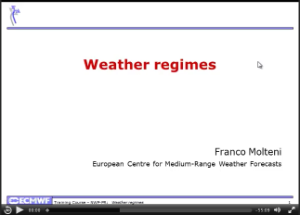
This lecture was delivered by Dr. Franco Molteni and recorded in May 2014. Click here to download the recording |
|
|
| Expand |
|---|
| title | CLICK HERE FOR MORE RESOURCES..... |
|---|
| | Section |
|---|
| Column |
|---|
| | Panel |
|---|
| bgColor | white |
|---|
| title | Towards an earth system model |
|---|
| 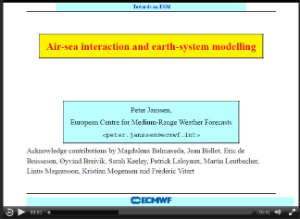
Recently, there is in increasing interest in trying to understand the properties of coupled atmosphere, ocean-wave, ocean/sea-ice models with an ultimate goal to start predicting weather, waves and ocean circulation on time scales ranging from the medium-range to seasonal timescale. Such a coupled system not only requires the development of an efficient coupled forecasting system but also the development of a data assimilation component.This lecture was delivered by Dr. Peter Jansen and recorded in May 2014. Click here to download the recording |
|
| Column |
|---|
| | Panel |
|---|
| bgColor | white |
|---|
| title | Seasonal Forecast at ECMWF |
|---|
| 
This lecture was delivered by Dr. Laura Ferrati and recorded in February 2014. It describes the Seasonal Forecasting system at ECMWF, its products and their interpretation. Click here to download the recording (the lecture in pdf format can be downloaded here). |
|
| Column |
|---|
| | Panel |
|---|
| bgColor | white |
|---|
| title | Forecasting tropical cyclones in the medium range |
|---|
| 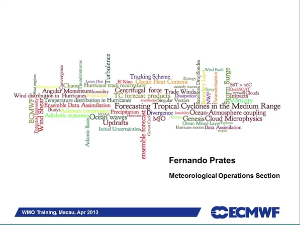
This lecture was delivered by Mr. Fernando Prates and recorded in February 2015. It describes the tropical cyclone tracker and ECMWF ensemble products for forecasting tropical cyclones. Click here to download the recording (the lecture in pdf can be downloaded here). |
|
|
| Section |
|---|
| Column |
|---|
| | Panel |
|---|
| bgColor | white |
|---|
| title | Ensemble forecasting: can they help making decisions? |
|---|
| 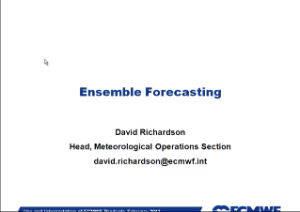
This lecture was delivered by Mr. David Richardson and recorded in February 2015. It describes ECMWF ensemble prediction system and how it can be used in the decision making process. Click here to download the recording (the lecture in pdf can be downloaded here). |
|
| Column |
|---|
| | Panel |
|---|
| bgColor | white |
|---|
| title | Forecasting Waves |
|---|
| 
This lecture was delivered by Dr. Jean Bidlot and recorded in February 2014. It describes ECMWF wave model and its products. Click here to download the recording (the lecture in pdf can be downloaded here). |
|
| Column |
|---|
| | Panel |
|---|
| bgColor | white |
|---|
| title | Monitoring satellite observations |
|---|
| 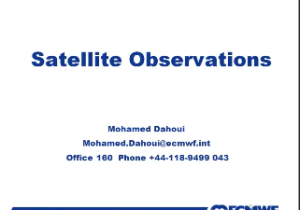
This lecture was delivered by Dr. Mohamed Dahoui and recorded in February 2015. It shows the satellite monitoring techniques with specific emphasis on ECMWF monitoring suite. Click here to download the recording (the lecture in pdf can be downloaded here). |
|
|
| Section |
|---|
| Column |
|---|
| | Panel |
|---|
| bgColor | white |
|---|
| title | Data assimilation |
|---|
| 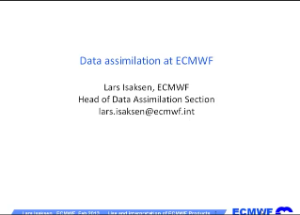
This lecture was delivered by Dr. Lars Isaksen and recorded in February 2015. It describes the data assimilation system at ECMWF, and its future evolution. Click here to download the recording. |
|
| Column |
|---|
| | Panel |
|---|
| bgColor | white |
|---|
| title | ecCharts |
|---|
| 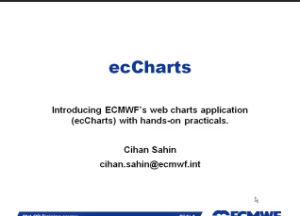
This lecture was delivered by Mr. Cihan Sahin and recorded in February 2013. It is a basic introduction to a web based application called ecCharts to visualise ECMWF data. Click here to download the recording. |
|
| Column |
|---|
| | Panel |
|---|
| 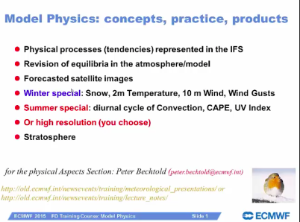
The lecture was delivered by Dr. Peter Bechtold during the training course in 2015. It reviews the physical parameterisation in the ECMWF model. Click here to download the recording (the lecture in pdf can be downloaded here) |
|
|
|
|
panel
| Panel |
|---|
| bgColor | white |
|---|
titleBGColor | cream |
|---|
| Background Color |
|---|
| | color | #EAEAEAOur Tutorials (videos) |
|---|
| Background Color |
|---|
| ECPDS |
| Section |
|---|
| Column |
|---|
| | Panel |
|---|
| bgColor | white |
|---|
| title | ECPDS Intro (13 min) |
|---|
|  Image Added Image Added
In this page you will find a collections of short videos on the main architecture behind ECPDS (ECMWF Production Dissemination System), main concepts supporting it and how to use it. The short videos describe the main functionalities of ECPDS to help getting started with the system. Click here to go to the ECPDS tutorial page  Image Removed Image Removed
The video explains the main architecture behind ECPDS followed by the main concepts behind it such us Destination and Host and the configurable options that they have. Click here to see the video |
|
| Column |
|---|
| | Panel |
|---|
| bgColor | white |
|---|
| title | Login - Status (7 min) | ecFlow |
|---|
| ecFlow is a work flow package that enables users to run a large number of programs (with dependencies on each other and on time) in a controlled environment. It provides reasonable tolerance for hardware and software failures, combined with good restart capabilities. It is used at ECMWF to around half our operational suites across a range of platforms  Image Removed Image Removed
The video shows how to log in to ECPDS, start and stop and check the several status of a destination. Click here to see start the videoonline tutorial |
|
| Column |
|---|
| | Panel |
|---|
| bgColor | white |
|---|
| title | Data file filters (5 min) | Metview |
|---|
|  Image Added Image Added
Metview is a meteorological workstation application designed to be a complete working environment for both the operational and research meteorologist. Its capabilities include powerful data access, processing and visualisation.  Image Removed Image Removed
The video explains the file filters available in ECPDS and how to see the volumes in dissemination. Click here to see go to the videoonline tutorials |
|
|
|
expand| Panel |
|---|
| Background Color |
|---|
| Our training lectures (presentations in PDF) |
| Section |
|---|
| title | CLICK HERE FOR MORE ECPDS VIDEOS..... |
|---|
| | Section |
|---|
| Column |
|---|
| 30% | | Panel |
|---|
| bgColor | white |
|---|
| title | ECMWF computing services, archiving and software - 2017 |
|---|
| The courses aim to introduce participants to ECMWF's new computing services and software: | Requeue files (10 min) |  Image Removed Image Removed
The video explains the transfer table and how to requeue files, change priorites, extend lifetime ... Click here to see the video | Column |
|---|
width | 30%browse the presentations for "Introduction to ECMWF computing and the Meteorological Archival and Retrieval System" Click here to browse the presentations for "ecCodes: GRIB encoding and decoding software" Click here to browse the presentations for "High Performance Computing Facility: Cray XC40" |
|
| Column |
|---|
| | Panel |
|---|
| bgColor | white |
|---|
| title | NWP lectures - 2017 |
|---|
| The objective of the meteorological training course is to assist Member States in advanced training in the field of numerical weather forecasting. The course is divided into modules covering different aspects of NWP: Data Assimilation, Predictability and ocean-atmosphere ensemble forecasting, Parametrization of surged physical processes, Advanced numerical methods for Earth-system modelling | Host Configuration / Traceroute (3 min) |  Image Removed Image Removed
The video explains how to see host configuration, activate/deactivate hosts, make traceroute/ping. Click here to see the videobrowse the presentations (not yet available)
|
| Column |
|---|
| 30% | | Panel |
|---|
| File Errors (3 min) |  Image Removed Image Removed
The video shows how to look at file - info and transfer errors. Click here to see the video |
| Use and Interpretations of ECMWF products - 2017 |
| This course provides theoretical background information on ECMWF forecasting system and hands on experience in using ECMWF meteorological products both in the forecasting room and in making more informed decisions when weather plays a key role. Click here to browse the presentations |
|
|
| Expand |
|---|
| title | CLICK HERE FOR MORE RESOURCES... |
|---|
| | Section |
|---|
| Column |
|---|
| | Panel |
|---|
| bgColor | white |
|---|
| title | Timeline (3 min) | ECMWF computing services, archiving and software - 2016 |
|---|
| The courses aim to introduce participants to ECMWF's new computing services and software: Click here to browse the presentations for "Introduction to ECMWF computing and the Meteorological Archival and Retrieval System" Click here to browse the presentations for "ecCodes: GRIB and BUFR encoding and decoding software" Click here to browse the presentations for "High Performance Computing Facility: Cray XC30"  Image Removed Image Removed
The video shows the timeline funtionality, which allows to identify problems with transfers when they take longer than usual. Click here to see the video |
|
| Column |
|---|
| | Panel |
|---|
| bgColor | white |
|---|
| title | Monthly and Seasonal Files (3.5 min) |
|---|
|  Image Removed Image Removed
This video shows how to find the monthly, hindcast and seasonal files in ECPDS. Click here to see the video |
|
|
|
|
| Panel |
|---|
| Background Color |
|---|
|
Our NWP training material |
| Section |
|---|
| Expand |
|---|
| title | Data Assimilation Presentations 2015 |
|---|
|
Lecture Guide and Learning Goals
This year we are providing an overview of each of the lectures and the things you should learn from each lecture. Click on a lecture title to find out more...
Downloads of the presentations are available below each lecture
| Monday | Tuesday | Wednesday | Thursday | Friday |
|---|
| Expand |
|---|
| title | Introduction. Operational and research activities at ECMWF now/in the future |
|---|
| In this lecture we will give you a brief history of ECMWF and present the main areas of NWP research that is currently being carried out in the centre. We then look at current research challenges and present some of the latest developments that will soon become operational. By the end of the lecture you should be able to: - List the main research areas at ECMWF and describe the latest model developments.
|
Erland Källén, Sarah Keeley | Assimilation Algorithms: (2) 3D-Var
Mike Fisher
TC_lecture_2.pdf
Assimilation Algorithms: (3)
4D-Var
Mike FisherTC_lecture_3.pdf
| Expand |
|---|
| title | Ensemble Kalman filters |
|---|
| | The aim of this lecture is to introduce the concept of the EnKF in the context of atmospheric data assimilation. Strengths and weaknesses of the algorithm will be discussed and results of the ECMWF implementation will be presented. By the end of the lecture the participants should be able to: • Describe the basic EnKF algorithm and its connections with the Kalman Filter; • Discuss some of the advantages and the limitations of EnKF algorithms with respect to more established variational algorithms; • Be aware of recent developments in hybrid variational-EnKF data assimilation |
Massimo Bonavita Bonavita_EDA_TC2015.pdf
| | Expand |
|---|
| title | Ensemble of Data Assimilations and uncertainty estimation |
|---|
|
The Ensemble of Data Assimilations (EDA) technique is used for the estimation of the analysis and background errors of the ECMWF assimilation system. This lecture describes the EDA formulation and implementation, and how it interacts with ECMWF 4DVar analysis and ECMWF Ensemble Prediction System. By the end of the lecture the participants should be able to: - Describe the theoretical basis and practical implementation of the EDA
- Explain the use of the EDA in the ECMWF analysis and ensemble prediction systems
|
Massimo Bonavita
Bonavita_EDA_TC2015.pdf
Assimilation Algorithms: (1) Basic concepts Mike Fisher TC_lecture_1.pdf
| Background error modeling and non-Gaussian aspects of data assimilation
Elias Holm
BGErr_lecture_2014.pdf
| Expand |
|---|
| title | Ocean Data Assimilation |
|---|
|
This lecture provides an overview of a typical ocean data assimilation system for initialization and re-analyses application. The lecture uses as an example the ECMWF ocean data assimilation system, which is based the NEMOVAR (3Dvar FGAT). This will be used to discuss design of the assimilation cycle, formulation of error covariances, observations assimilated and evaluation procedure, among others. By the end of the lecture students should be able to: - describe the different components involved in a an ocean data assimilation system
- list the commonalities and and differences between ocean and atmosphere data assimilation
- describe the basics of the physical ocean observing system
- explain the essential multivariate relationships between ocean variables
- identify the limitations of the existing systems.
|
Magdalena Alonso-Balmaseda
tcourse15_da_ocean.pdf
| Expand |
|---|
| title | Analysis of Satellite Data |
|---|
|
The primary purpose of this lecture is explore the implications of the fact that satellites can only measure radiation at the top of the atmosphere and do not measure the geophysical variables we require for NWP (e.g. temperature, humidity and wind). The link between the atmospheric variables and the measured radiances is the radiative transfer equation - the key elements of which are discussed. It is shown how - with careful frequency selection - satellite measurements can be made for which the relationship to geophysical variables is greatly simplified. Despite these simplifications, it is shown that the extraction of detailed profile information from downward looking radiance measurements is a formally ill posed inverse problem. Data assimilation is introduced as the solution to this inverse problem, where background information and satellite observations are combined to produce a best or optimal estimate of the atmospheric state. The main elements of the assimilation scheme (such as the chain of observation operators for radiances) and its key statistical inputs are examined. In particular it is shown that incorrect specification of observation errors (R) and background errors (B) can severely limit the successful exploitation of satellite data. By the end of this lecture you will: - understand exactly what a satellite actually measures (radiance)
- appreciate the complex relationship between what is measured and what we wish to know for NWP
- how information is extracted from satellite measurements in data assimilation
|
Tony McNally
DA_TC_satellite.pdf
| Expand |
|---|
|
In this lecture, the impact of model error on variational data assimilation will be presented. This lecture will introduce weak-constraint 4D-Var as a way to account for model error in the data assimilation process. Several examples of results from simplified implementations in the IFS will be shown. By the end of the lecture the participants should be able to: - describe the impact of model error on the data assimilation process,
- explain the difficulties in properly accounting for model error in data assimilation.
|
Yannick Tremolet
Weak4DVar2015.pdf
| Expand |
|---|
| title | The Global Observing System |
|---|
|
The aim of this session is to present an overview of the current observing systems used in Numerical Weather Prediction. We will discuss our observational requirement, and how close the current observing system is to meeting our needs. We will also discuss areas where our requirements are evolving. We will learn about WMO's OSCAR database that describes the Global Observing System. We will learn how the large diversity of observations now available, are monitored to ensure only good observations are presented to an operational system. By the end of the session you should be able to: - be able to describe the main types of observations used in data assimilation for Numerical Weather Prediction;
- be aware of how large volumes of observations are exchanged, implemented and monitored in operational systems;
- be aware of WMO's OSCAR database, how to access it and what type of information it can provide.
|
Tony McNally
DA_TC_GOS.pdf
| Expand |
|---|
| title | Land Data Assimilation - Soil moisture |
|---|
|
The aim of these sessions is to understand the role of land surface data assimilation on medium range weather forecasts. We will give an overview of the different approaches used to assimilate land surface data and to initialise model variables in NWP. We will present the current observing systems and describe the land data assimilation structure within ECMWF system. By the end of the session you should be able to: - identify the different observations used for snow and soil moisture data assimilation
- define land surface data assimilation approaches used for NWP
- describe the role of land surface data assimilation on medium-range weather forecasts
|
Patricia de Rosnay
surface_analysis_2015_part2.pdf
| Expand |
|---|
| title | Tangent Linear and Adjoints |
|---|
| The goal of this lecture is to familiarise the student with the notion of tangent linear and adjoint models, and their use in variational data assimilation. A general overview of the current use of tangent linear and adjoint models in the ECMWF system will also be provided. Theoretical definitions and practical examples of tangent liner and adjoint models will be given. The student will be invited to work some simple tangent linear and adjoint derivations together with the instructor. A brief introduction to automatic differentiation software will also be given./ By the end of the session you should be able to: - define what tangent linear and adjoint models are
- derive tangent linear and adjoint equations for a simple nonlinear equation
- describe the use of tangent linear and adjoint codes within the ECMWF's 4D-VAR system.
|
Angela Benedetti Training_course_2015_TLAD.pdf
| Diagnostics: (2) Forecast Sensitivity
Carla Cardinali
FSOI_Lecture2.pdf
| Expand |
|---|
| title | Data Assimilation of Atmospheric Composition |
|---|
| At ECMWF atmospheric composition data are assimilated into the IFS as part of the MACC-II project. On a global scale, atmospheric composition represents the full state of the global atmosphere covering phenomena such as desert dust plumes, long-range transport of atmospheric pollutants or ash plumes from volcanic eruptions, but also variations and long-term changes in the background concentrations of greenhouse gases. The aim of this lecture is to give an overview of the work that is carried out at ECMWF regarding the assimilation of atmospheric composition data, and to address why this is of interest and which special challenges are faced when assimilating atmospheric composition data. By the end of the session you should: - have some understanding of the work carried out at ECMWF to assimilate data of atmospheric composition
|
Antje Inness EnvMoni_2015.pdf | | Expand |
|---|
| title | Land Data Analysis System - screen level parameters and snow |
|---|
| The aim of these sessions is to understand the role of land surface data assimilation on medium range weather forecasts. We will give an overview of the different approaches used to assimilate land surface data and to initialise model variables in NWP. We will present the current observing systems and describe the land data assimilation structure within ECMWF system. By the end of the session you should be able to: - identify the different observations used for snow and soil moisture data assimilation
- define land surface data assimilation approaches used for NWP
- describe the role of land surface data assimilation on medium-range weather forecasts
|
Patricia de Rosnay surface_analysis_2015_part1.pdf
| Diagnostics (1) Self Sensitivity
Carla Cardinali
Observation_Influence_Lecture1.pdf
Toy Model Practice Session (1) OR Mike Fisher, Yannick Tremolet, Martin Leutbecher | | Expand |
|---|
|
The aim of this session is to understand how data assimilation can improve our knowledge of past weather over long time-scales. We will present recent advances that help capture changes over time in observing system networks, and project this variation in information content into uncertainty estimates of the reanalysis products. We will also discuss the applications of reanalysis, which generally put weather events into the climate context. By the end of the session you should be able to: - explain what are the goals of data assimilation in a reanalysis data assimilation system
- list the key aspects that require particular attention in reanalysis, as compared to numerical weather prediction
- describe the most common problems in reanalysis products
|
Paul Poli
Poli_2015_TC_DA_Reanalysis_with_notes.pdf
Quality Control of observations
Elias Holm VarQC_lecture_2014.pdf
| Aspects of using observations in data assimilation
Lars Isaksen
LI_DA_TC_2015_Observations.pdf
Followed by drinks reception
| Expand |
|---|
| In this lecture the variational bias correction scheme (VarBC) as used at ECMWF is explained. VarBC replaced the tedious job of estimating observation bias off-line for each satellite instrument or in-situ network by an automatic self-adaptive system. This is achieved by making the bias estimation an integral part of the ECMWF variational data assimilation system, where now both the initial model state and observation bias estimates are updated simultaneously. By the end of the session you should be able to realize that: - many observations are biased, and that the characteristics of bias varies widely between types of instruments
- separation between model bias and observation bias is often difficult
- the success of an adaptive system implicitly relies on a redundancy in the underlying observing system.
|
Hans Hersbach Hersbach_2015_TC_BiasCorrection.pdf | Toy Model Practice Session (2) OR Mike Fisher, Yannick Tremolet, Martin Leutbecher | | Expand |
|---|
| title | Parameterization and Data Assimilation |
|---|
| | This one-hour lecture will identify the challenges associated with the use of physical parametrizations in the context of four-dimensional variational data assimilation (4D-Var). The importance of the linearity constraint in 4D-Var and the methods to address it will be detailed. The set of linearized physical parametrizations used at ECMWF will be briefly presented. Examples of the use of physical parametrizations in variational data assimilation and its impact on forecast quality will be given. By the end of the lecture, the students should be able: - to tell why physical parametrizations are needed in data assimilation.
- to recognize the importance of the regularization of the linearized code
|
Philippe Lopez TC_DA_lopez_2015_main.pdf
| Question/answer session
Elias Holm, Lars Isaksen, Tony McNally, Mike Fisher Course evaluation 16:-16:30 Sarah Keeley
| | Expand |
|---|
| title | Advanced Numerical Methods |
|---|
|
|
| Expand |
|---|
| title | Parametrization of sub-grid scale processes |
|---|
|
|
| Expand |
|---|
| title | Predicatbility and ocean-atmosphere ensemble forecasts |
|---|
|
Week 2:
Clustering techniques and their applications Laura Ferranti Clustering_LF_2015_final.pdf
| Post-processing of ensemble forecasts Tim Stockdale tc2015_calibration.pdf
| Practice Session: Ensemble predictions and Risk Evaluation | | |
Practice Session: Ensemble Verification Simon Lang/Linus Magnusson | Application of ENS: Health Francesca Di Guiseppe digiuseppe_application_health_training_course_2015.pdf
| Question and Answer session:
Tim Stockdale, Franco Molteni, Martin Leutbecher, Roberto Buizza
| | Practice Session: Ensemble Verification Simon Lang/Linus Magnusson | Application of ENS: Ocean wave Jean Bidlot Bidlot_Ensemble_wave_products.pdf | Course wrap up and certificates Sarah Keeley | | |
Sea ice modelling and predictability in polar regions Sarah Keeley SeaIce_2015_cr.pdf | Application of ENS: Drought Emanuel Dutra pr_eps_app_drought_dutra_28042015.pdf
| | | |
Initializaton techniques in seasonal forecasting Magdalena Balmaseda tcourse15_Initialization.pdf
| Multi-model ensemble predictions on seasonal timescales Tim Stockdale tc2015_multimodel.pdf
| | | |
Week 1:
Introduction to the course
...
Initial uncertainties in the medium-range ENS (1)
Linus Magnusson
traning_2015_inipert1_lm.pdf
...
Teleconnections & interannual variability of the atmosphere
Franco Molteni
TCPR_Molteni_2015_telecon.pdf
...
Ensemble verification (2)
Martin Leutbecher
handout_v2.pdf
...
Mark Rodwell
see previous lecture for notes
| The objective of the meteorological training course is to assist Member States in advanced training in the field of numerical weather forecasting. The course is divided into modules covering different aspects of NWP: Data Assimilation, Predictability and ocean-atmosphere ensemble forecasting, Parametrization of surged physical processes, Advanced numerical methods for Earth-system modelling. Click here to browse the presentations |
|
| Column |
|---|
| | Panel |
|---|
| bgColor | white |
|---|
| title | Use and Interpretations of ECMWF products - 2016 |
|---|
| This course provides theoretical background information on ECMWF forecasting system and hands on experience in using ECMWF meteorological products both in the forecasting room and in making more informed decisions when weather plays a key role. Click here to browse the presentations |
|
|
| Section |
|---|
| Column |
|---|
| | Panel |
|---|
| bgColor | white |
|---|
| title | ECMWF Cray supercomputing services - 2015 |
|---|
| The course aims to introduce participants to ECMWF's new Cray supercomputing services, covering those areas of optimisation that will help the student to make more efficient use of the system and avoiding the areas which may adversely impact overall system performance. Click here to browse the presentations |
|
| Column |
|---|
| | Panel |
|---|
| bgColor | white |
|---|
| title | ECMWF computing and software services - 2015 |
|---|
| The courses aim to introduce participants to ECMWF's new computing services and software: Click here to browse the presentations for "Introduction to ECMWF computing and the Meteorological Archival and Retrieval System" Click here to browse the presentations for "GRIB API" |
|
| Column |
|---|
| | Panel |
|---|
| bgColor | white |
|---|
| title | Use and Interpretations of ECMWF products - 2015 |
|---|
| This course provides theoretical background information on ECMWF forecasting system and hands on experience in using ECMWF meteorological products both in the forecasting room and in making more informed decisions when weather plays a key role. Click here to browse the presentations Click here to browse the videos
|
|
|
| Section |
|---|
| Column |
|---|
| | Panel |
|---|
| bgColor | white |
|---|
| title | Introduction for new users including MARS - 2014 |
|---|
| The aim of this module is to introduce students to ECMWF's basic computing services, both the workstation system (ecgate) and the data storage/archive facility. MARS is the Centre's meteorological data archive. This course is aimed at new users of ECMWF's computer services. Click here to browse the presentations |
|
| Column |
|---|
| | Panel |
|---|
| bgColor | white |
|---|
| title | NWP lectures - 2014 |
|---|
| The objective of the meteorological training course is to assist Member States in advanced training in the field of numerical weather forecasting. The course is divided into modules covering different aspects of NWP: Data Assimilation, Predictability and ocean-atmosphere ensemble forecasting, Parametrization of subgrid physical processes, Advanced numerical methods for Earth-system modelling. - Data Assimilation: Click here to browse presentations
- Predictability and ocean-atmosphere ensemble forecasting: Click here to browse presentations
- Parametrization of subgrid physical processes: Click here to browse presentations
- Advanced numerical methods for Earth-system modelling: Click here to browse presentations
|
|
| Column |
|---|
| | Panel |
|---|
| bgColor | white |
|---|
| title | GRIB API: library and tools - 2014 |
|---|
| GRIB API is a GRIB decoding/encoding software developed at ECMWF. It supports GRIB edition 1 and 2 with the same function calls and has both a Fortran interface and C interface. Click here to browse the presentations |
|
|
|
|
...
Tim Palmer - given by Sarah Keeley
IntroChaos.pdf
...
Initial uncertainties in the medium-range ENS (2)
Simon Lang
lang1.pdf
...
Ensemble verification (1)
Martin Leutbecher
handout_v1.pdf
...
Franco Molteni
TCPR_Molteni_2015_regimes.pdf
...
The monthly forecast system at ECMWF
Frederic Vitart
TCPR_Vitart_2015.pdf
...
Roberto Buizza
RB_2015_03_TCL1_sources_uncert.pdf
Operational and research activities at ECMWF now/in the future
Sarah Keeley & Erland Källén
ECMWF-Past-Future_2015.pdf
...
Ensemble data assimilation
Roberto Buizza
RB_2015_03_TCL3_EDA.pdf
...
Mark Rodwell
rodwell1Printv220415.pdf
The seasonal forecast system at ECMWF
Tim Stockdale
tc2015_seasonal.pdf
Sources of predictability beyond the deterministic limit
Sarah Keeley
Sources_predictability2.pdf
...
Using stochastic physics to represent model error
Sarah-Jane Lock
TCPredictability_stochastic_sjlock_2015_vprint.pdf
...
Coupled ocean-atmosphere variability
Magdalena Balmaseda
tcourse15_ocean.pdf
...
Practice Session:
Martin Leutbecher
handout_lorenzToy.pdf
...
2.45pm Discussion Session in the Weather Room
...
General Circulation Revision
Erland Källén
GenCirc_ECMWF_trainingcourse.pdf
...
Approaches to ensemble prediction/TIGGE
Roberto Buizza
RB_2015_03_TCL2_TIGGE.pdf
...
Towards an Earth System Model
Peter Janssen
lectures_esm_short_2015.pdf
...
Practice Session:
Martin Leutbecher
Lecture and Practice Session:
Application of ENS: Flood
Fredrik Wetterhall
...

































